How Long To Cook A Prime Rib To Medium Rare
Learn How to Cook a Perfect Prime Rib Roast Recipe & Cooking Instructions in six easy steps:
1. Prime Rib Size & Purchasing Tips
2. Dry Aging Prime Rib – Optional
3. Preparing Prime Rib Roast to Cook
4. Prime Rib Internal Temperatures
5. Prime Rib Roast Recipe
6. Carving Prime Rib Roast
Side Dishes for Prime Rib Roast
Yorkshire Pudding Recipe
Gravy, Au Jus & Sauce Recipes
Prime Rib Dinner Menus & Recipes
Comments and Photos from Readers
Perfect prime rib roast recipe just in time for the holidays!
What is a Prime Rib? A Prime Rib Roast is a very tender, flavorful, and usually an expensive cut of beef. Also known as a Standing Rib Roast, it is a popular centerpiece to a Christmas table and other festive holidays throughout the year. Prime Rib Roast is a tender cut of beef taken from the rib primal cut. The generous marbling and fatty layer are what gives this cut the distinct and juicy flavor that you are paying for, so leave it on the roast. After making the perfect prime rib roast recipe for the holidays, you will never go back to turkey again!
Want to try another Prime Rib flavor dimension? Learn how to cook Smoked Prime Rib low and slow for a succulent kiss-of-smoke flavor that melts in your mouth.
Perfect Prime Rib Roast Recipe:
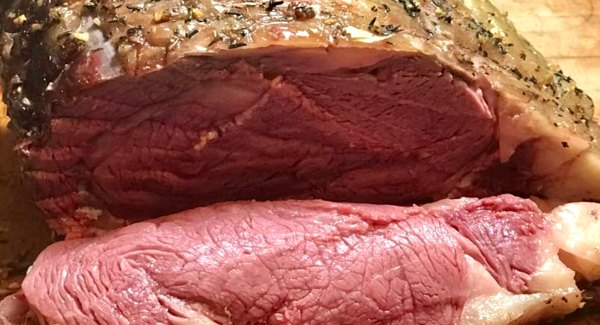
*Cooking time varies upon size of prime rib roast - expect 2 - 4 hours for roasting time.
- 1 Prime Rib Roast standing rib roast at room temperature (very important)
- 2 tablespoons butter at room temperature
-
Preheat oven to 450 degrees F. Pat the room-temperature standing rib roast (prime rib roast) dry with paper towels or napkins. Smear the cut ends only of the roast with the butter.
-
Previously Frozen Roast: If your prime rib roast is frozen, let it thaw completely in the refrigerator. Remove the roast from the refrigerator about 2 to 4 hours before cooking to let it come to room temperature. Depending on the size of your roast, the time to come to room temperature may vary. I can not give you an exact time on this. Use your best judgment! -
Room Temperature: To cook evenly, the roast must not be cold - let it stand at room temperature, loosely covered, for about 2 to 4 hours. This time can vary depending on how big or small your roast is. I can not give you an exact time on this. If you do not let the roast come to room temperature, if will take longer to cook your roast, your roast won't cook evenly, and you will end up with well-done slices on the end and raw meat in the center. Use your best judgment on room temperature times! -
Do NOT salt the outside of your prime rib roast, as salt draws out moisture from the meat while cooking. You can use a prime rib rub containing other seasonings if desired, but I find it is not necessary. I know that some people do salt their prime rib roast before cooking, but trust me and do no salt - the result will be a juicy, delicious roast to serve your family and guests! -
Roasting Pan: Place the roast, ribs down or fat side up, in a heavy stainless-steel Roasting Pan or other metal roasting pan. Select a roasting pan that has sides at least 3-inches deep.(I do not recommend using nonstick pans, as these pans yield fewer of the cooked-on bits that make the tasty au jus juice or gravy.) The rib bones are a natural rack; you will not need a metal one. -
Cooking Temperatures: Sear the rib roast for 15 minutes at the higher oven temperature (450 degrees F.), then turn the oven to the lower temperature (325 degrees F.) for the rest of the cooking time. Every 1/2 hour, baste the cut ends of the roast with the fat accumulated in the roasting pan.Do Not Cover the roast. -
You will want to estimate about 12 minutes per pound of meat for the cooking time. See charts to make it easy to determine Prime Rib Roast Cooking Times. About 45 minutes before the estimated end of the roasting (bake) time, begin checking the internal temperature (use a good instant-read digital meat thermometer). Play it safe and start checking early, as you do not want anything to go wrong. This is even more important if you are adjusting for High Altitude Baking. -
If you ignore every other bit of advice I have given, please pay attention to this: For a perfectly cooked rib roast, invest in a good meat thermometer. Internal temperature, not time, is the best test for doneness and you do not want to blow this meal!
-

This is the type of cooking and meat thermometer that I prefer and use in my cooking. I get many readers asking what cooking/meat thermometer that I prefer and use in my cooking and baking. I, personally, use the Thermapen Thermometer shown in the photo on the right. To learn more about this excellent thermometer and to also purchase one (if you desire), just click on the underlined: Thermapen Thermometer.
-
When checking the temperature of your prime rib roast, insert meat thermometer so tip is in thickest part of beef, not resting in fat or touching bone. Cook until rib roast reaches an internal temperature of 120 degrees F. (or your desired temperature). See chart to determine Prime Rib Roast Internal Cooking Temperatures for rare, medium-rare, medium, medium-well and well-done. Remove from oven, cover loosely with aluminum foil, and let sit approximately 15 to 20 minutes.Cutting into the meat too early will cause a significant loss of juice. Do not skip the resting stage. -
Residual Heat or Carry-Over Cooking: Remember, the rib roast will continue to cook as it sets. The internal temperature will rise to 125 degrees F. to 130 degrees F. (medium rare) in approximately 15 to 20 minutes. If allowed to rest as long as an hour, the internal temperature will rise even higher. So, pay attention to how long you let the cooked prime rib roast sit. -
Holding Cooked Rib Roast:To hold cooked roast until serving time, immediately turn off the oven and leave the door ajar after removing roast. Let roast sit 15 minutes on the counter and then return roast to the oven, door closed, for up to an hour or even 2 hours for the biggest roasts.Check the temperature every 15 minutes. If will rise approximately 10 degrees F. at first, then gradually subside.
-
If Using a Convection Oven: Using a convection oven can cut as much as 25% off the cooking times listed for the regular oven.It is also easier for your roast to dry out and cook too much in the convection oven. Watch the roast carefully and please use a cooking thermometer to know when the roast is done and should be taken out of the oven.
Back to the top
Watch the video to learn how to make perfect prime rib
What Size of Prime Rib Roast to Buy?
A common question people ask is "How much prime rib roast should I buy per person?" A full prime rib roast is seven (7) ribs, close to 15 to 18 pounds, and enough to feed a crowd of 14 or more people (depending on how big of eaters they are). The term "standing" means the bones are included in the roast, thus the roast can stand by itself. A prime rib roast comprises of seven ribs starting from the shoulder (chuck) down the back to the loin.
Do not even bother with less than a three-rib roast, any less than that is not a roast but rather a thick steak and would be better treated as such. For a generous serving of roast, figure on two people per rib. That means if you plan to serve:
two (2) people – one (1) rib roast
six (6) people – three (3) rib roast
eight (8) people – four (4) rib roast
ten (10) people – five (5) rib roast
twelve (12) people – six (6) rib roast
fourteen (14) people – seven (7) rib roast
How To Purchase A Prime Rib Roast:
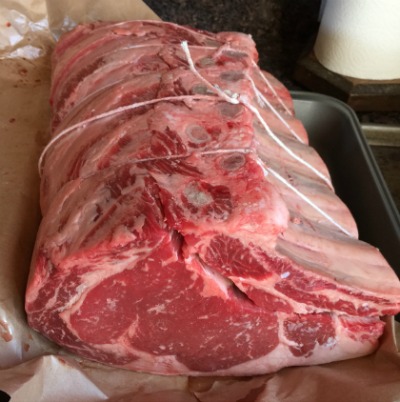
First of all, let's dispel a common myth: The term prime rib does not necessarily indicate a rib roast is a prime grade, and in most cases, it probably is not. Prime is an official USDA designation of grade and few supermarkets display this elite grade of beef because of its high cost relative to other grades. Prime Rib has become more a style of cooking the meat than of the quality of the cut. This is also why you rarely see this cut labeled as Prime Rib at the supermarket but rather as Beef Bone-In Rib Roast because the USDA requires that a cut of beef must be officially graded as Prime before it can be so labeled.
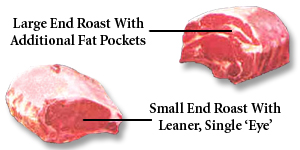 Insisting you get a rib roast that is actually prime grade is well worth the effort for this perfect prime rib roast recipe. Less than 2% of all industry beef merits this designation from the USDA. You will likely have to ask your butcher to special order a true Prime grade rib roast for your occasion, but when the forks hit the plate, your family and guests will notice the difference and then some!
Insisting you get a rib roast that is actually prime grade is well worth the effort for this perfect prime rib roast recipe. Less than 2% of all industry beef merits this designation from the USDA. You will likely have to ask your butcher to special order a true Prime grade rib roast for your occasion, but when the forks hit the plate, your family and guests will notice the difference and then some!
One universal truth of the meat world is that fat means flavor! But of course, many prefer a leaner cut, and the whole beef rib (where rib roasts are portioned) was kind enough to offer both. The whole piece is divided roughly in half, a large end and a small end. The large end is defined by the presence of more fat pockets throughout the meat, while small end rib roasts contain a single, intact muscle and are leaner. Whether one is better than the other is really never more than a matter of personal taste and how much fat your diet will tolerate. In choosing between them and determining which will better suit your palate, it may help some of you to know that the small end is where a butcher produces boneless rib eye steaks, and the large end yields Delmonico steaks.
Grading Cuts of Beef:
Does the grade of the meat make much of a difference? You bet it does – The better the grade of beef, the less you have to do to it! The higher the USDA grade, the more money you will pay.
The USDA's grading system gives a good way to assess quality. The grading designations are largely determined by the amount of visible fat that's streaked throughout the muscle tissue, called marbling. Beef that's richly marbled gets a higher grade; it is more tender, juicy, and flavorful because the intramuscular fat melts and bastes the flesh during cooking.
Prime – The highest grade in the U.S. meat grading system. Prime has the most marbling and is produced in limited quantities. Prime beef is most commonly sold in fine restaurants and specialty meat markets.
Choice – Choice has less marbling than Prime but more than Select. It is typically found in the service meat case at your local grocery store.
Select – Select has the least amount of marbling of the top three grades, making it leaner but possibly less tender, juicy or flavorful than Prime or Choice. Select is most commonly found in the self-service meat case at your local grocery store.
Beware of marketing deceptions where some grocery stores or supermarkets may try to fool an unsuspecting consumer by using the words "prime"and "choice"without being attached to the official "USDA shield." Unless prime and choice carry the USDA label, what you are buying may not be the real thing.
Size of Prime Rib Roast To Purchase: A whole standing rib roast (prime rib roast) consists of ribs 6 through 12. Most GOOD butchers recommend that you request a rib roast from the small end toward the back of the rib section, which is leaner and gives you more meat for your dollar. This cut is referred to as the first cut, the loin end, or sometimes the small end because the meat and ribs get larger as they move up toward the shoulder.I do NOT recommend purchasing a boneless rib roast, as roasting with the bones adds flavor. But, if you do purchase a boneless prime rib roast, cook using the same guidelines as a roast with ribs. Usually, the weight is figured without the bones. If in doubt, weight your roast before cooking it.
Package Date: Be sure and check the date the prime rib was packaged. This is an indicator as to how long it has been sitting around in the store. Look at the color of the prime rib; it should have a bright red color and no dry or brown edges. Check for any damage to the packaging and wrapping.
The Bones: Have the butcher cut off the chine bones from the bottom of the roast and the rib bones from the meat just along the bone line but do not discard them. They can be cut off in separate pieces or the chine bones can be cut off as one piece with the rib bones. Have the meat placed back on the rib bones and wrap them along with the chine bones to take home to cook along with the roast. Your butcher will also tie the bones back on the roast if you ask. Having the bones cut away from the meat before cooking will make carving the finished prime rib a lot easier.
Back to the top
How To Prepare Prime Rib Roast:
Photos in this section by Perrin Kliot, Berkerley, CA.
Fat Cap or Lid: The fat provides the flavor and what you are paying for with prime rib, so leave it on. Some rib roasts are sold with the thick fat cap on top of the meat intact, and some are trimmed. I prefer to have most of the fat cap intact and trimmed to an even layer approximately 1/4-inch to 1/2-inch thickness. Most butchers will trim the fat down for you.
You could trim the trim the fat yourself by using a sharp thin knife to trim the fat on the top of the roast to 1/2-inch thickness. Trim roast of excess fat, but not the thin layer of fat (the fat cap or lid) the butcher leaves on the roast to protect and baste it while it cooks. Excess fat means any fat more than one (1) inch thick. So – it is up to you if you want the fat cap left on your prime rib or if you want it removed.
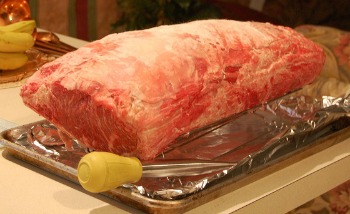
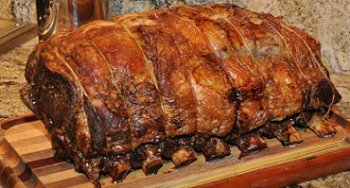
First photo shows fat cap intact on an uncooked prime rib roast before cooking – Photo by the Barkers in West Bloomfield, MI
Second photo show fat cap intact on a cooked prime rib roast – Photo by Perrin Kliot, Berkerley, CA.
Tying Up Prime Rib Roast: It is important to tie the prime rib before roasting. If left untied, the outer layer of meat will pull away from the rib-eye muscle and overcook. To prevent this problem, tie the roast a both ends, running the cooking twine parallel to the bone. Most butchers will tie your rib roast for you – so ask the butcher!
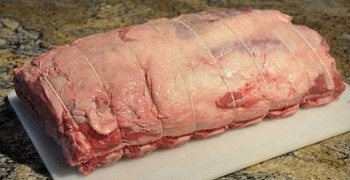
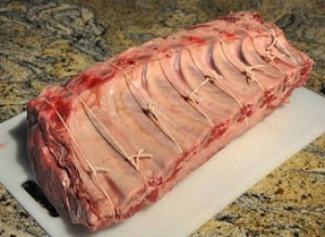
Tie the roast at both ends, running the cooking twine parallel to the bone. Tie the meat to the rib bones and include the chine bones at the bottom of the prime rib roast. Tie around the meat and ribs in between the bones on each end, making sure to tie the chine bones to the meat also. Also, tie around the meat and bones in the center of the prime rib.
Back to the top
Optional – Dry Aging Prime Rib Roast:
Dry Aging is optional, but if you have the time and the space in your refrigerator, you can dry age the raw prime rib roast for several days to bring out additional flavor and produce a more buttery texture in prime rib roast (aging allows the natural enzymes to break down some of the protein in the meat). Dry-aged beef can be expensive to purchase and hard to come by. Some top-quality butchers will offer already dry-aged prime rib roasts for sell. If you can find one and can afford one (as they are pricey), purchase the roast.
A food safety note: Home refrigerators are not as consistent or as cold as commercial meat lockers. Before aging you rare prime rib roast at home, get a Refrigerator Thermometer and be sure your refrigerator is set below 40 degrees F.
How to dry-age raw prime rib roast at home – The good news is that you can dry-age beef at home:
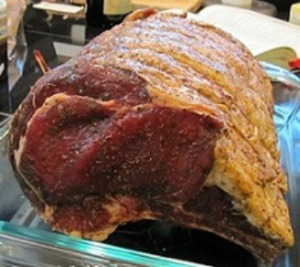
Only the top grades of beef can be dry aged successfully. Use USDA Prime or USDA Choice from the best meat source in your area. Buy a whole prime rib roast or rib-eye roast. Unwrap the beef (do not trim), rinse it well with cold water, allow the meat to drain, and pat then pat the meat dry with paper towels.
Wrap the roast loosely in a triple layer of immaculately clean cheesecloth or plain white cotton dish towels (this will help to draw moisture away from the meat) and set it on a rack over a rimmed baking sheet or other tray. Place the wrapped roast on the bottom shelf of the refrigerator (which is the coldest spot in your refrigerator). Refrigerate for 7 to 10 days (the longer the beef ages, the tastier it gets). After the first day, carefully unwrap and then rewrap with the same cheesecloth to keep the cloth fibers from sticking to the meat.
When ready to roast, unwrap the meat and, with a sharp knife, shave off and discard the hard, dried outer layer of the meat. Shave away any dried areas of fat, too, but leave behind as much of the good fat as possible. NOTE: There can be much waste as the dried and sometimes moldy meat needs to be trimmed away before cooking and eating it.
Back to the top
Prime Rib Roast Cooking Internal Temperature Chart:
The chart below is only a guide. You must rely on an accurate Meat Thermometer and start taking temperatures about 45 minutes before the end of the estimated roast time. Reminder: Instant-read thermometers are not meant to be left in the roast during the cooking process.
What constitutes rare and medium-rare cooked meat?
To satisfy government home economists, the Beef Council says rare beef means an internal temperature of 140 degrees F. Well, that is ok if you like well-done and dry meat. If you like moist, rosy meat (like I do), rare begins at an internal temperature of 120 degrees F. and starts to become medium rare at 125 to 130 degrees F. To cook your meat properly, you must purchase and use a good instant-read digital meat thermometer.
 This is the type of cooking and meat thermometer that I prefer and use in my cooking. I get many readers asking what cooking/meat thermometer that I prefer and use in my cooking and baking. I, personally, use the Thermapen Thermometer shown in the photo on the right. To learn more about this excellent thermometer and to also purchase one (if you desire), just click on the underlined: Thermapen Thermometer.
This is the type of cooking and meat thermometer that I prefer and use in my cooking. I get many readers asking what cooking/meat thermometer that I prefer and use in my cooking and baking. I, personally, use the Thermapen Thermometer shown in the photo on the right. To learn more about this excellent thermometer and to also purchase one (if you desire), just click on the underlined: Thermapen Thermometer.
Also, learn How To Test and Calibrate a Cooking or Meat Thermometer.
How To Check Oven Temperature – Oven temperatures are not always correct. In fact, they can often be off by 25 to 50 degrees F. The will seriously affect the baking time of your prime rib (standing rib roast).
To check the temperature of your oven, place an oven thermometer on the center rack and heat the oven for 15 minutes at 350 degrees F. If, after 15 minutes, the oven temperature reads higher or lower than your oven setting, adjust your oven setting for your prime rib baking and for all your future baking.
Approximate Prime Rib Cooking Time Per Pound until Internal Temperature reaches 120 degrees F:
1 rib (2 to 2.5 pounds) – 22 to 24 minutes
2 ribs (4 to 5 pounds) – 60 to 70 minutes
3 ribs (7 to 8.5 pounds) – 1-1/2 to 1-3/4 hours
4 ribs (9 to 10.5 pounds) – 1-3/4 to 2-1/4 hours
5 ribs (11 to 15 pounds) – 2-1/4 to 3 hours
6 ribs (15 to 16 pounds) – 3 to 3-1/4 hours
7 ribs (16 to `8.5 pounds) – 3-1/4 to 4 hours
Beef Roast Cooking Internal Temperatures:
Rare – 120 to 125 degrees F. – center is bright red, pinkish toward the exterior portion
Medium Rare – 130 to 135 degrees F. – center is very pink, slightly brown toward the exterior portion
Medium – 140 to 145 degrees F. – center is light pink, outer portion is brown
Medium Well – 150 to 155 degrees F. – not pink
Well Done – 160 degrees F. and above
High Altitude Baking:Above 2,500 feet, the atmosphere becomes much drier. The air has less oxygen and atmospheric pressure, so cooking takes longer. Use the sea-level time and temperature guidelines when oven-roasting beef, as oven temperatures are not affected by altitude changes. Allow additional cooking time for your prime rib roast at high altitude. I can not give you the exact cooking time. Using a cooking thermometer is the only way to measure whether your roast has reached a safe internal temperature. In a high-altitude environment, it is easy to overcook the meat.
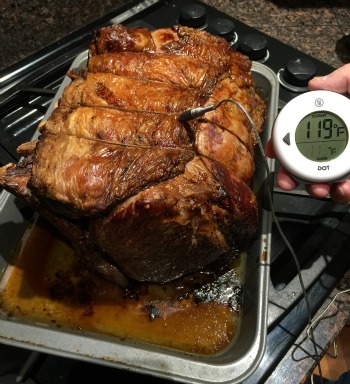
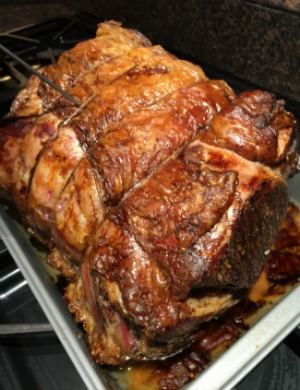
Photo on left – Prime Rib almost done – just 1 degree to go for rare.
Photo on right – Prime Rib cooked to perfection!
Back to the top
How to Carve Prime Rib Roast:
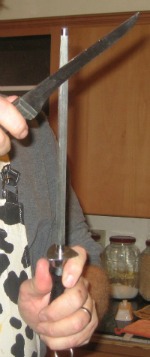
Use a long, thin, sharp knife. Sharpen you carving knife, if necessary, using either a sharpening rod or stone.
Steel Sharpening Rod – To use a Steel Sharpening Rod or Steel pull the edge down and across the rod, holding the carving knife at a 22-degree angle. Repeat this process anywhere from 5 to 10 times.
Sharpening Stone (whetstones) – To use a Sharpening Stone (whetstones), hold the carving knife at a 10- to 15-degree angle to the stone. Push back and forth in smooth, steady strokes.
(1) Place the cooked prime rib on a large Meat Cutting Board with a well at one end to hold the juice. Remove the cooking twine that is tied around the roast.
(2) Use a carving fork to hold roast in place. Turn the platter to where the rib bones are on your left, if you are right-handed, and on your right if you use your left hand to carve.
(3) Using your sharp carving knife, make one cut to slice off the chine or feather bones (the large-end bones) to sever meat from bones in one piece.Note: Save the bones for nibbling on later or for making a delicious Beef Stock to use in soups, stews, and pot roast recipes. You could also save the bones to make a pot of Caldo de Res (Mexican Beef Soup).
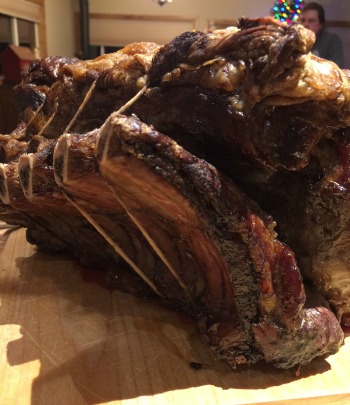
(4) Set roast cut-side down. Slice the meat across the grain to the thickness you prefer.
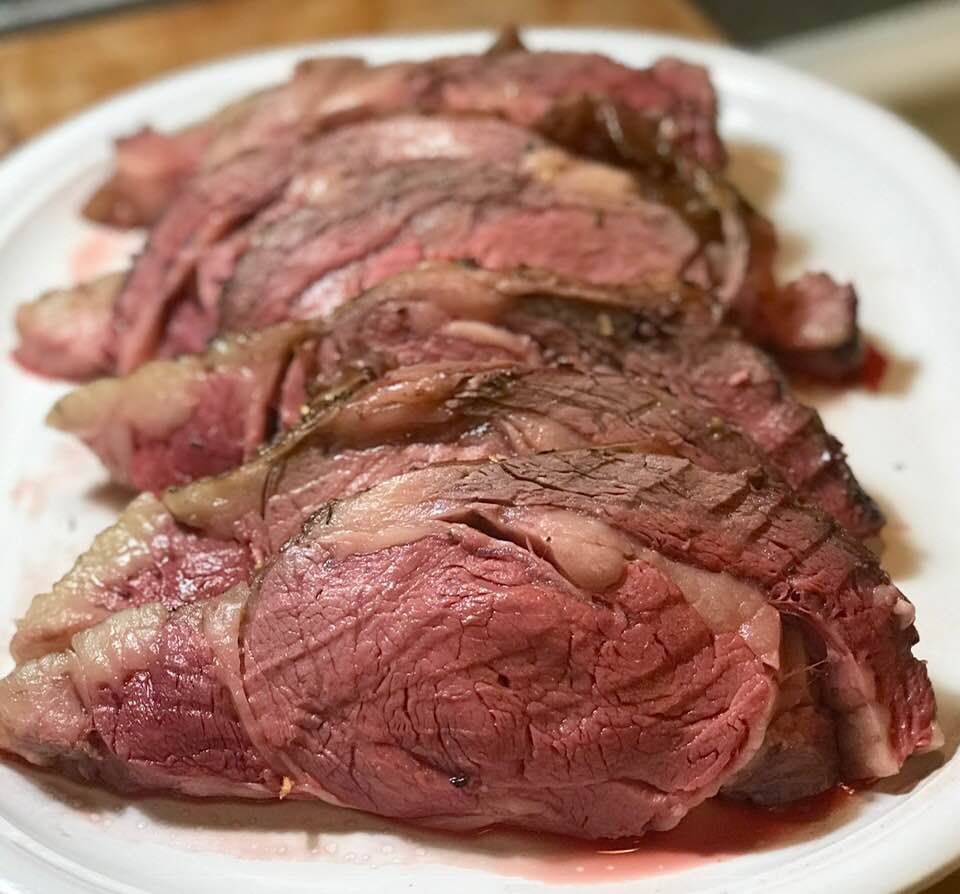
Back to the top
Side Dish Recipes:
Learn the essential and classic side dish recipes that go well with a prime rib roast. We have provided the must-have sides to dress up your perfect prime rib roast recipe, including making either a gravy or au jus sauce from the meat drippings. You can also use the meat drippings for Yorkshire pudding pop-over pastry and, do not forget a side of horseradish or blue cheese sauce. We have also listed some of our favorite vegetable side dishes for potatoes, spinach, green beans, and corn.
How To Make Prime Rib Gravy:
Remember – Gravy is different than Au Jus Juice (see Au Jus Juice below).
After the perfect prime rib roast recipe (standing rib) is done, remove from the oven and remove from the roasting pan. Place the cooked prime rib on a large Meat Cutting Board with a well at one end to hold the juice.
Place roasting pan over two (2) burners on the stove over medium heat (always make the gravy in the same pan you used to roast the prime rib roast).
Skim and discard any excess fat from the juices in the roasting pan. Using a heavy spoon, scrape all the dark drippings and any crunchy bits from the sides and bottom of roasting pan.
FOR EACH 2 CUPS OF GRAVY:
Ingredients:
Use 3 tablespoons liquid fat (fat is in the drippings left in the bottom of your roasting pan)
3 tablespoons all-purpose flour
2 cups of liquid (meat juices/drippings, or broth, vegetable juice, bouillon, wine, and/or water)
In a separate container with a lid, shake together all-purpose flour and about 2 cups cool water.This is called a slurry. Adding the thickener (flour) in this way helps to prevent lumps from forming.
Preparation:
Once the drippings in the pan are lightly bubbling, slowly add the slurry mixture to the gravy pan, stirring constantly with a wire whisk. If it starts to thicken, immediately stop adding the remaining slurry. You may not need to use all the slurry, depending on how much or little drippings were left in the roasting pan.
If lumps do develop, you should be able to use a wire whisk to remove them. If all else fails and you can not remove the lumps, just place mixture in your blender or food processor and process until smooth.
If your gravy is too thick, add additional liquid, stirring constantly. Season to taste with salt and pepper.
Au Jus Juice Recipe:

Au Jus is a French term meaning "with juice." The term is used to describe the serving of meat, most often prime rib roast, surrounded in or served with a container of the natural juices that were produced as drippings while the meat was being cooked. It is not thick like a typical sauce or gravy. Also, check out my web page on Beef Au Jus – Au Jus Beef Juice.
While the cooked prime rib roast is standing or resting for the required resting period, make the "au jus" sauce.
IMPORTANT: Making Au Jus is more of a technique and not a recipe. You will have to do this by feel or guesswork. It depends on how much juice is left in your pan (plus the juice from slicing the prime rib roast), and how many people you will be serving.
Ingredients:
Beef juices from cooked perfect prime rib roast recipe
Beef broth/stock*
Red wine (of your choice)**
* The au jus will only be as good as your beef stock (and also the red wine you use), so it is recommended that you use homemade Beef Stock, if possible. If you must use canned stock, buy the best you can find, but forget about using salty, artificially-flavored bouillon cubes.
** I like to add some of the same red wine that I will be serving with the meal.
Add your beef broth and/or wine according to how much Au Jus you think you will need for each person being served. I wish I could give you exact directions, but it is impossible to have an exact recipe for this.
Preparation:
Pour off all but 2 tablespoons of the fat (leaving the beef juices in the pan) from the roasting pan and discard the remaining fat (or reserve if making Yorkshire puddings).
Place the roasting pan on two (2) burners on medium heat. Add the beef stock and stir and scrape to release any browned bits in the pan. Add red wine of your choice. Bring mixture to a boil and cook until the stock is slightly reduced, about 5 minutes.NOTE: Au jus is not thick like a typical sauce or gravy. Season to taste with salt and pepper.
Transfer to a gravy boat or serve in small individual containers for each guest.
Leftovers: Use any leftover Prime Rib and Au Jus for making French Dip Sandwiches for your family the next day. So good!
Yorkshire Pudding Recipe:
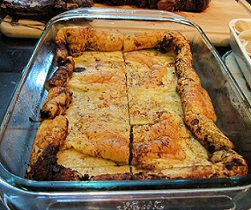
A traditional English side dish to Prime Rib Roast is Yorkshire Pudding, a puffy pop-over like pastry. Yorkshire Puddings, fresh from the oven, should be well-risen and golden brown with a crisp exterior and soft middle.
Ingredients:
3/4 cup all-purpose flour
1/2 teaspoon salt
3 eggs, room temperature
3/4 cup milk, room temperature
1/2 cup pan drippings from roast prime rib of beef (beef juices and oil)*
* If you do not have enough pan drippings, add melted butter.
Preparation:
At least two (2) hours or overnight before you will need this Yorkshire Pudding batter, prepare the batter (minus pan drippings), and place in the refrigerator. Yorkshire Pudding is cooked after you have taken your cooked prime rib roast out of the oven and you are letting it sit for the required resting period.
In a large bowl, sift together the flour and salt; set aside.
In another bowl, beat together the eggs and milk until light and foamy. Stir in the prepared flour/salt mixture just until incorporated and smooth.The batter will be like a very thin pancake batter.Cover bowl with plastic wrap and refrigerate at least two (2) hours (for best results, refrigerate overnight).
Cooking Yorkshire Pudding:
Traditionally Yorkshire Pudding is made in one large dish or your meat roasting pan and cut into wedges. For individual servings, I have found it is much easier to prepare them in muffin tins or popover pans. You be the judge of how you would like to cook and serve them. Also check out my web page on making Yorkshire Pudding.
After you take your cooked prime rib out of the oven, increase the oven temperature to 450 degrees F.
Pour the cooked prime rib meat drippings into your baking pan or muffin tins of choice. For a popover version, use popover pans or muffin pans, putting at least 1 teaspoon of meat drippings in the bottom of each well
Place the pan or pans in your oven and get the drippings smoking hot (about 5 minutes). Carefully take the hot pan/pans out of the oven.The fat in the popover or muffin tins should be almost smoking.
Remove the prepared cold batter from the refrigerator. Whisk the batter thoroughly to break down any lumps and add some additional air.
Quickly pour the batter into the hot pan/pans on top of the hot drippings. NOTE: If using popover or muffin pans, fill 1/3 full. The fat should sizzle when you pour the batter. Work quickly, so you do not lose all the oven heat.
Put the pan back in oven and cook until puffed and dry, approximately 15 to 20 minutes.Do not open the oven door during baking.
Remove from oven and serve hot with your Prime Rib Roast.
Makes approximately 6 individual popovers (depending on size of pans) or 1 large pan.
Back to the top
Sour Cream Horseradish Sauce Recipe:
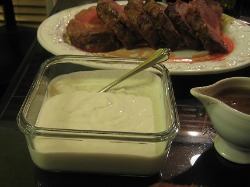
This is my favorite sauce to use with prime rib
1/4 to 1/2 cup prepared horseradish (according to your taste)
1 pint (2 cups) sour cream
2 tablespoons fresh-squeezed lemon juice
1 teaspoon salt
Directions:
In a medium-sized bowl, combine horseradish, sour cream, lemon juice, and salt; thoroughly mix. Refrigerate until ready to serve. Can be made 2 days in advance. Cover and refrigerate.
To serve, pass the horseradish sauce on the side.
Makes approximately 2 1/2 cups.
Garlic Blue Cheese Sauce Recipe:
3/4 cup heavy cream
1 medium garlic clove, thinly sliced
6 ounces blue cheese, crumbled
Freshly ground black pepper
In a medium-sized saucepan over medium-high heat, bring cream and garlic just to a boil. Lower heat and simmer until the cream coats the back of a spoon, approximately 5 to 10 minutes. Remove from heat.
Stir in the crumbled blue cheese. Season to taste with the pepper. Can be made 2 days in advance. Cover and refrigerate. Bring to room temperature before serving.
To serve, pass the Garlic Blue Cheese Sauce on the side.
Makes approximately 2 cups.
Apple Horseradish Sauce Cream – Low Fat:
1/4 cup grated tart apple
1/4 low-fat plain yogurt
1/4 cup light mayonnaise
1 teaspoon Dijon mustard
1 tablespoons prepared horseradish
In a medium-sized bowl, combine apple, yogurt, mayonnaise, Dijon mustard, and horseradish.
NOTE: Can be made 2 days in advance. Cover and refrigerate.
Makes approximately 2 1/2 cups.
 Some family favorite side dishes to serve with Classic Prime Rib:
Some family favorite side dishes to serve with Classic Prime Rib:
Perfect Baked Potatoes
Asiago and Sage Scalloped Potatoes
German Creamed Spinach
Country Style Green Beans
Green Bean Supreme Casserole
Southern Creamed Corn
Iowa Corn Au Gratin
Prime Rib Roast Dinner Menus & Recipes
Prime Rib Roast Recipes:
Prime Rib Roast with Balsamic Glaze
Standing Rib Roast with Rosemary-Thyme Crust
New! Smoked Prime Rib

Prime Rib Roast Menus:
If you are looking for Prime Rib Roast menu ideas for Christmas or another holiday meal, we have provided two great dinner menu options below. Prime Rib Roast always makes a meal exceptional when it is served to your family for Christmas dinner or another special holiday occasion.
Five-Course Christmas Prime Rib Dinner Menu & Recipes
Six-Course Best Christmas Prime Rib Dinner Menu & Recipes
I welcome your photos and comments on cooking your Prime Rib Roast. If you have the time, then please take the time to share with others. Contact Linda Stradley.
Comments and photos from Readers:
Check out the comments and photos sent to me in 2007 to 2016. As this web page had gotten too large, I had to place the comments on an additional page. Please also check them out.
How Long To Cook A Prime Rib To Medium Rare
Source: https://whatscookingamerica.net/beef/classicprimerib.htm
Posted by: desimonedoothis.blogspot.com

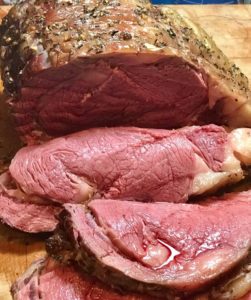
0 Response to "How Long To Cook A Prime Rib To Medium Rare"
Post a Comment